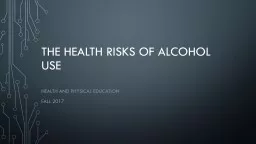

Health and Physical Education Fall 2017 Alcohol Alcohol advertisements show images of happy healthylooking young adults to sell a drug that is addictive physically damaging and often an entry into other drug use ID: 918763
Download Presentation The PPT/PDF document "The Health Risks of Alcohol Use" is the property of its rightful owner. Permission is granted to download and print the materials on this web site for personal, non-commercial use only, and to display it on your personal computer provided you do not modify the materials and that you retain all copyright notices contained in the materials. By downloading content from our website, you accept the terms of this agreement.
Slide1
The Health Risks of Alcohol Use
Health and Physical Education
Fall 2017
Slide2Alcohol
Alcohol advertisements show images of happy, healthy-looking young adults to sell a drug that is
addictive
, physically damaging, and often an entry into other drug use.
Alcohol, or more accurately
ethanol
–
the type of alcohol in alcoholic beverages
– is a powerful and addictive drug.
Ethanol can be produced synthetically or naturally by fermenting
fruits, vegetables, and grains
.
Slide3Alcohol (Continued)
Fermentation
is the chemical action of yeast on sugars
.
Water, flavoring, and minerals are mixed with ethanol to produce beverages such as
beer
,
wine
, and flavored
malt-liquor
drinks.
Alcohol can also be processed to create spirits, or liquors, such as
whiskey
and
vodka
.
Slide4Short-Term Effects of Alcohol
Alcohol is a
depressant
, a drug that slows down the central nervous system.
Using alcohol
slows
reaction time,
impairs
vision, and
diminishes
judgment.
If a person drinks too much alcohol, they will become intoxicated.
Intoxication
is the state in which the body is poisoned by alcohol or another substance, and the persons physical and mental control is significantly reduced.
Alcohol stays in a person’s system until the liver can
metabolize
it, or break it down.
Slide5Factors That Influence Alcohol’s Effects
Body Size
:
A smaller person feels the effects of the same amount of alcohol faster than a larger person does.
Gender
:
Alcohol generally moves into the bloodstream faster in females than in males.
Food
:
Food in the stomach slows down the passage of alcohol into the bloodstream.
Rate of Intake
:
If a person drinks alcohol faster than the lover can metabolize it, they will become intoxicated.
Amount
:
As the amount of alcohol consumed increases, the level of alcohol in the bloodstream rises.
Medicine
:
Alcohol can interfere with the effects of medicines, and medicines can heighten the effects of alcohol.
Slide6Alcohol and Drug Interactions
Alcohol can change the effect of medicines – these interactions can lead to
illness
or
death
.
Medicines that may cause reactions have
warning
labels that advise people not to use alcohol.
Note these typical alcohol-drug reactions:
The body may absorb the drug or alcohol more slowly, increasing the
length of time
that alcohol or drug is in the body.
Alcohol use can
decrease
the effectiveness of some medicines, and
increase
the effectiveness of others.
Enzymes in the body can change some medications into chemicals that can
damage
the liver or other organs.
Slide7Long-Term Effects of Alcohol
Alcohol use can have long-term effects on the users
physical, mental/emotional, and social health
.
The effects of alcohol may also be felt by the people who are close to someone who uses alcohol.
Excessive alcohol use over a long period of time can damage many of the body’s systems, such as:
Damage
to brain cells
Reduction
of brain size
Increase
in blood pressure (which can lead to heart attack or stroke)
Buildup
fat cells in the liver (which can lead to cell death)
Damage to the digestive lining of the stomach (which can cause
ulcers
or
cancer
)
Slide8Long-Term Effects of Alcohol (Continued)
The Brain
The Cardiovascular System
The Digestive System
The Pancreas
Addiction
:
Physical dependence can lead to the inability to control the frequency and amount of drinking.
Heart Damage
:
The heart muscles become weakened and the heart becomes enlarged, reducing its ability to pump blood. This damage can lead to heart failure. Reduced blood flow can damage other body systems.
Irritation of the Digestive Lining
:
Can lead to stomach ulcers and cancer of the stomach and esophagus.
Swelling of the Pancreas Lining
:
The passageway from the pancreas to the small intestine can become blocked, and chemicals needed for digestion cannot pass to the small intestine. The chemicals begin to destroy the pancreas itself, causing pain and vomiting.
Loss of Brain Function
:
Loss of verbal skills, spatial skills, and memory.
Fatty Liver
:
Fat builds up in the liver and cannot be broken down, leading to cell death.
Brain Damage
:
Excessive use of alcohol can lead to brain damage and a reduction of brain size. The learning ability and memory can be impaired.
High Blood Pressure
:
Damages the heart and can cause heart attack and stroke.
Alcoholic Hepatitis
:
Inflammation of the liver.
Cirrhosis of the Liver
:
Liver tissue is replaced with useless scar tissue. This can lead to liver failure and death.
Slide9Binge Drinking and Alcohol Poisoning
Binge Drinking
:
drinking 5 or more alcoholic drinks in one sitting
.
Binge drinking can severely impair the drinker’s body systems.
It can lead to
alcohol poisoning
–
a severe and potentially fatal physical reaction to an alcohol overdose
.
Slide10Effects of Alcohol Poisoning
A person who drinks too much alcohol may pass out. Even though the person is unconscious, the alcohol continues to enter the bloodstream. So even if someone is unconscious, their blood alcohol level will still rise. This increases the risk of
alcohol poisoning
.
Symptoms of alcohol poisoning:
Mental confusion and stupor
Coma and inability to be roused
Vomiting
and
seizures
Slow respirations (10 seconds between breaths OR fewer than 8 breaths per minute)
Irregular heartbeat
Hypothermia or low body temperature